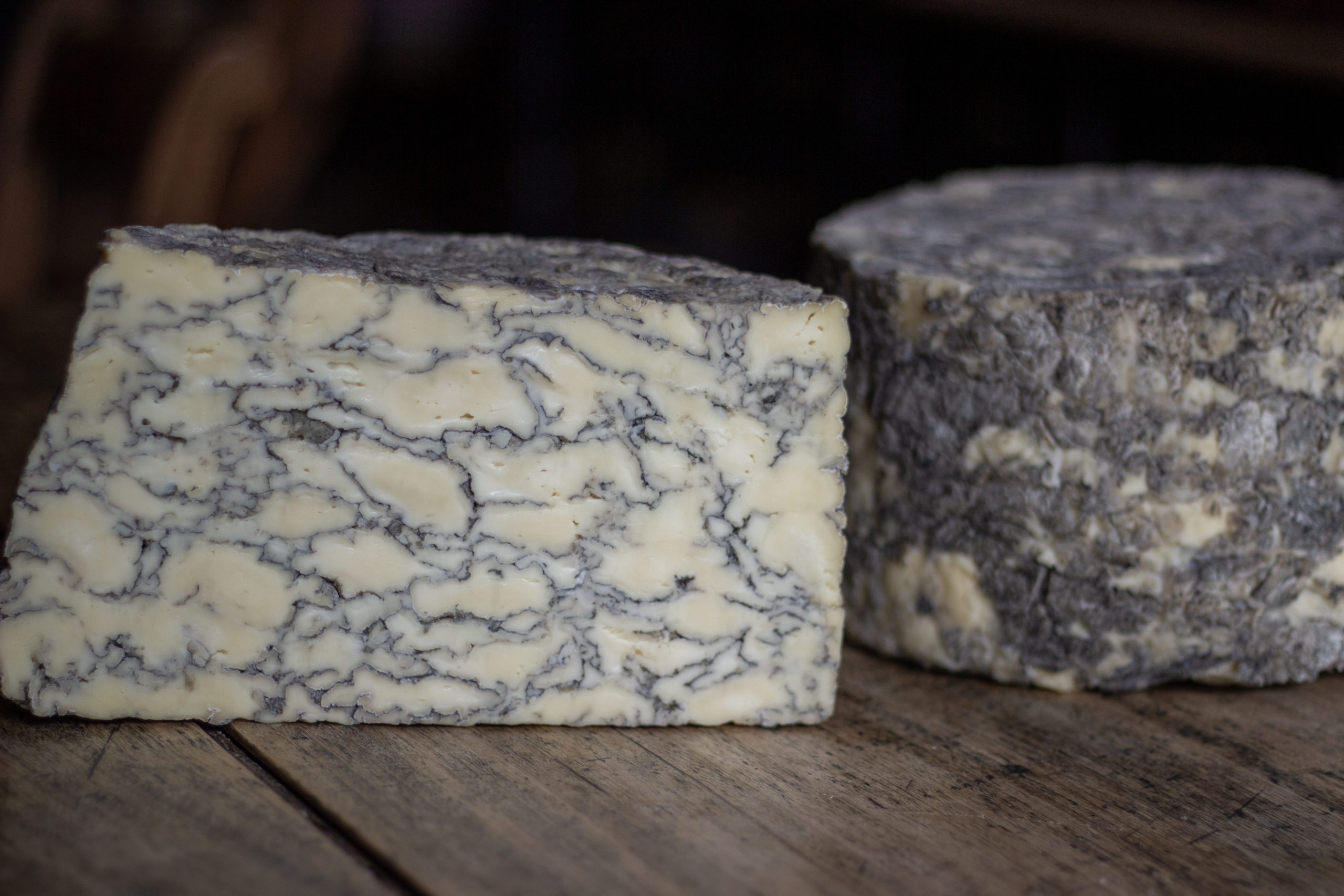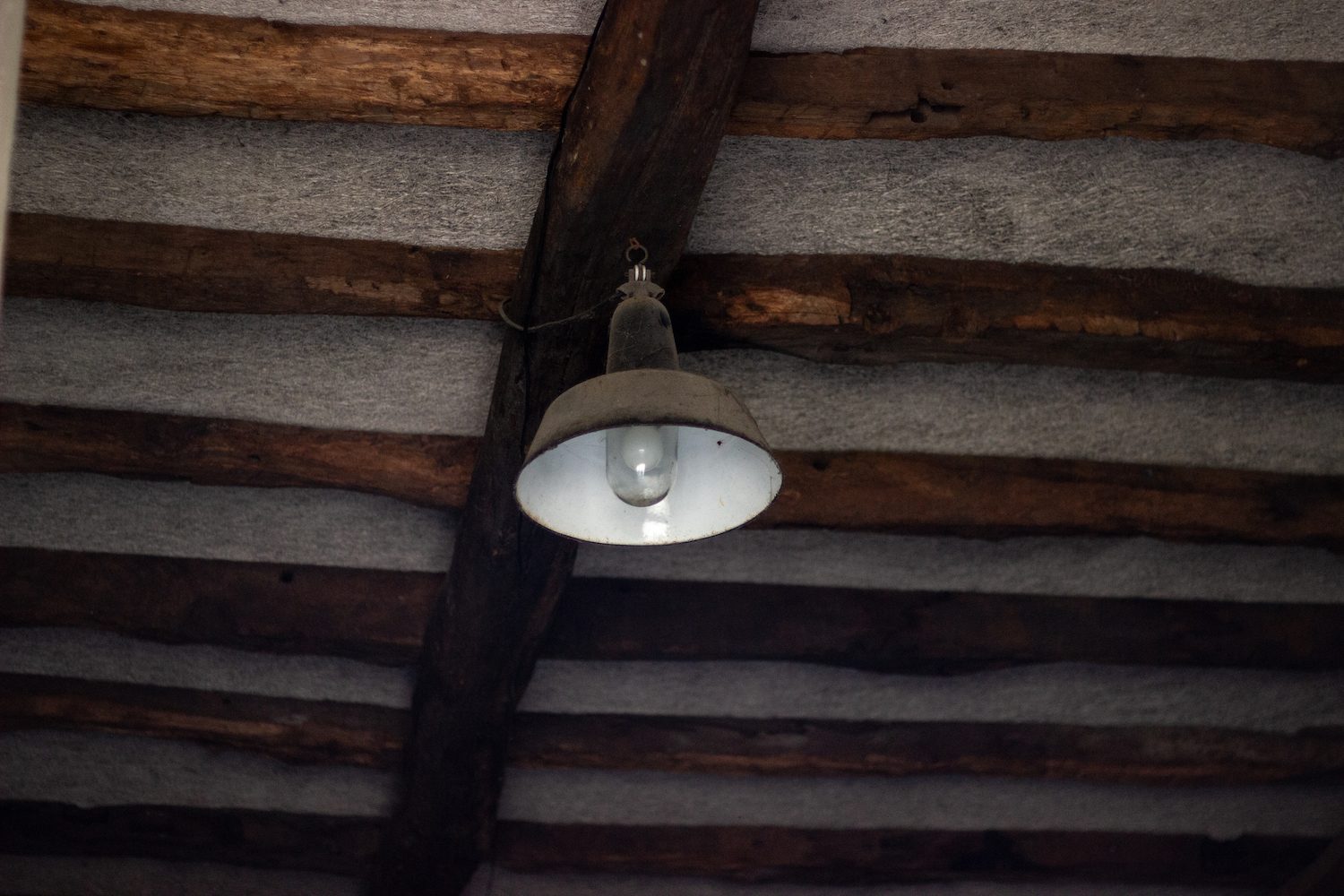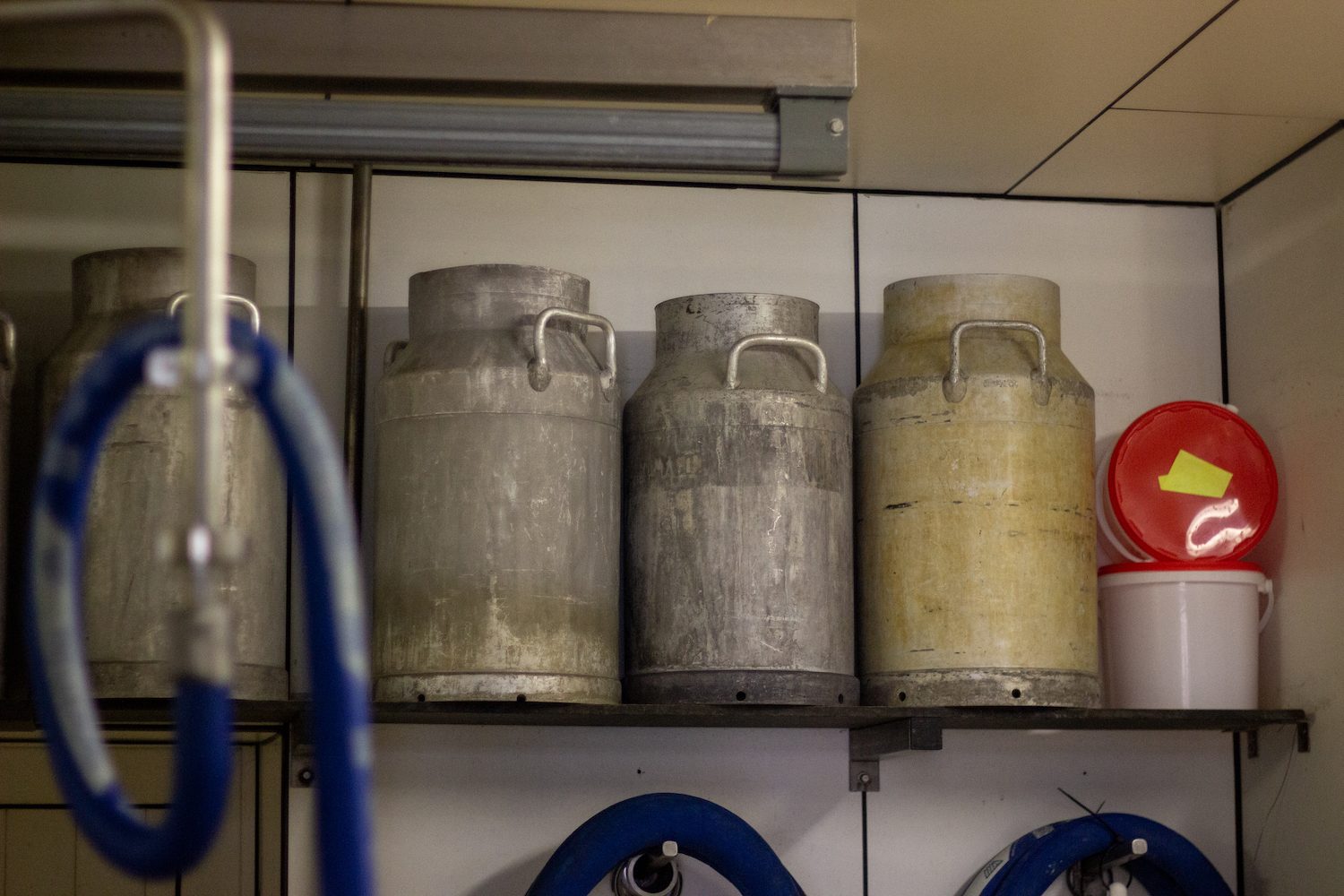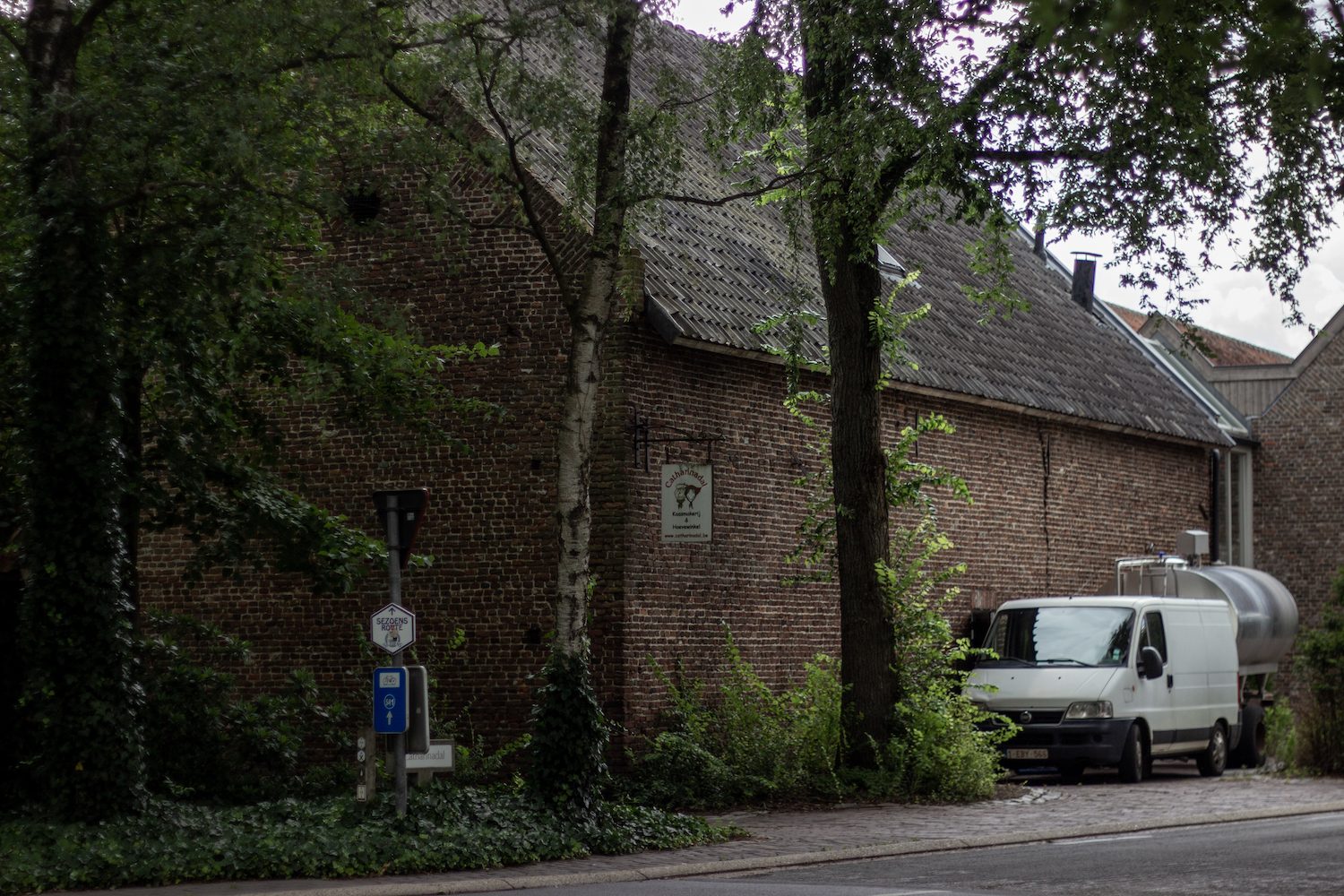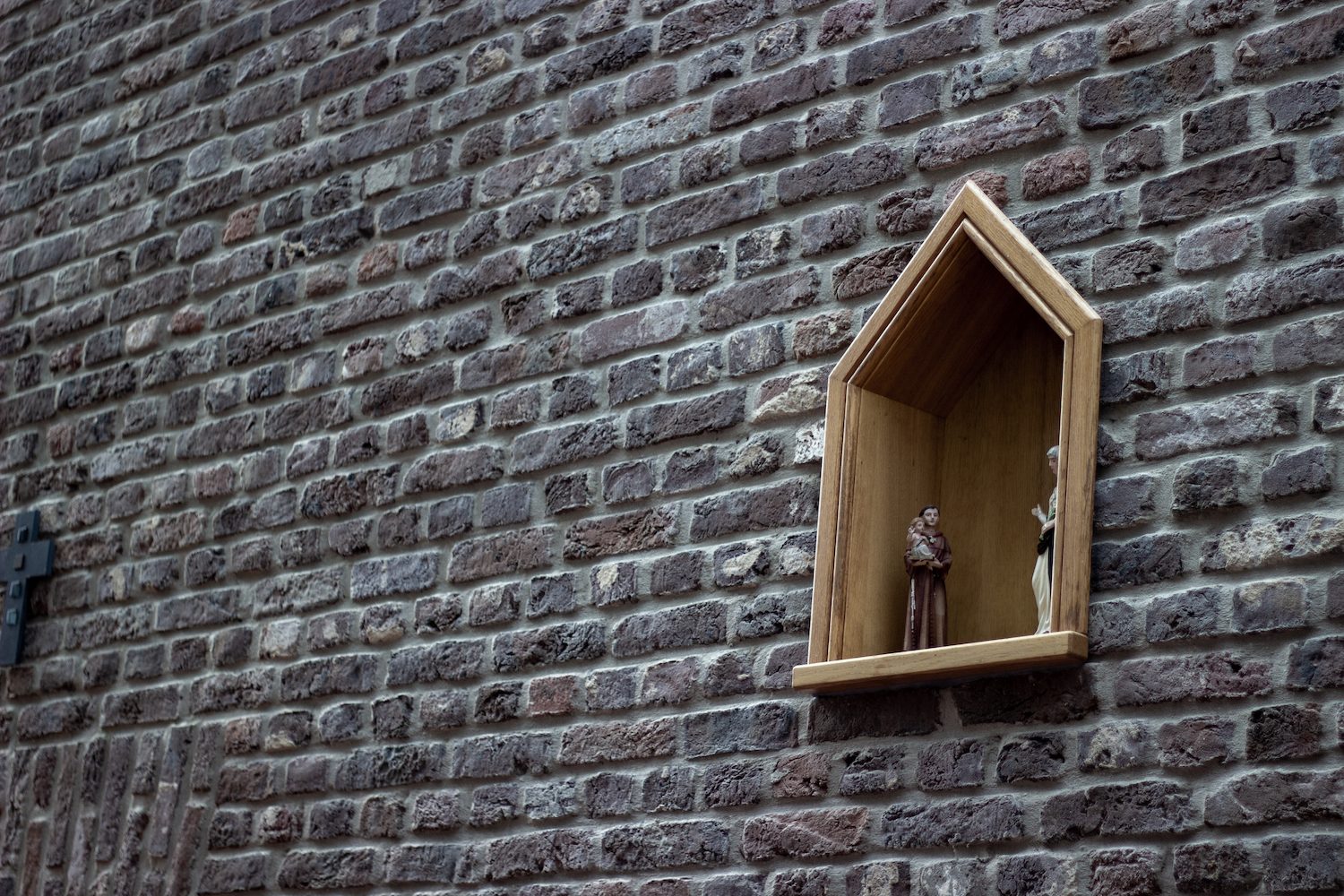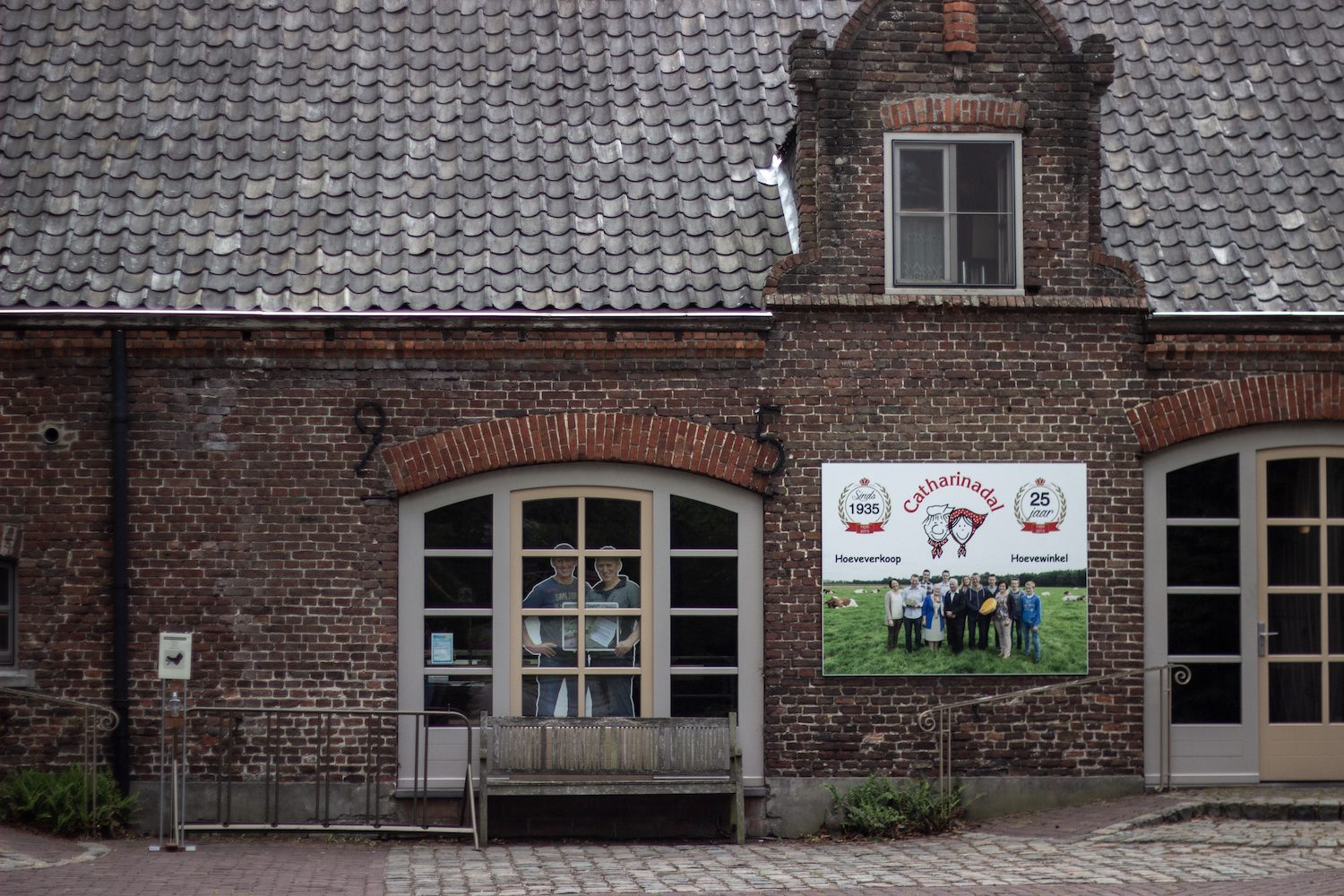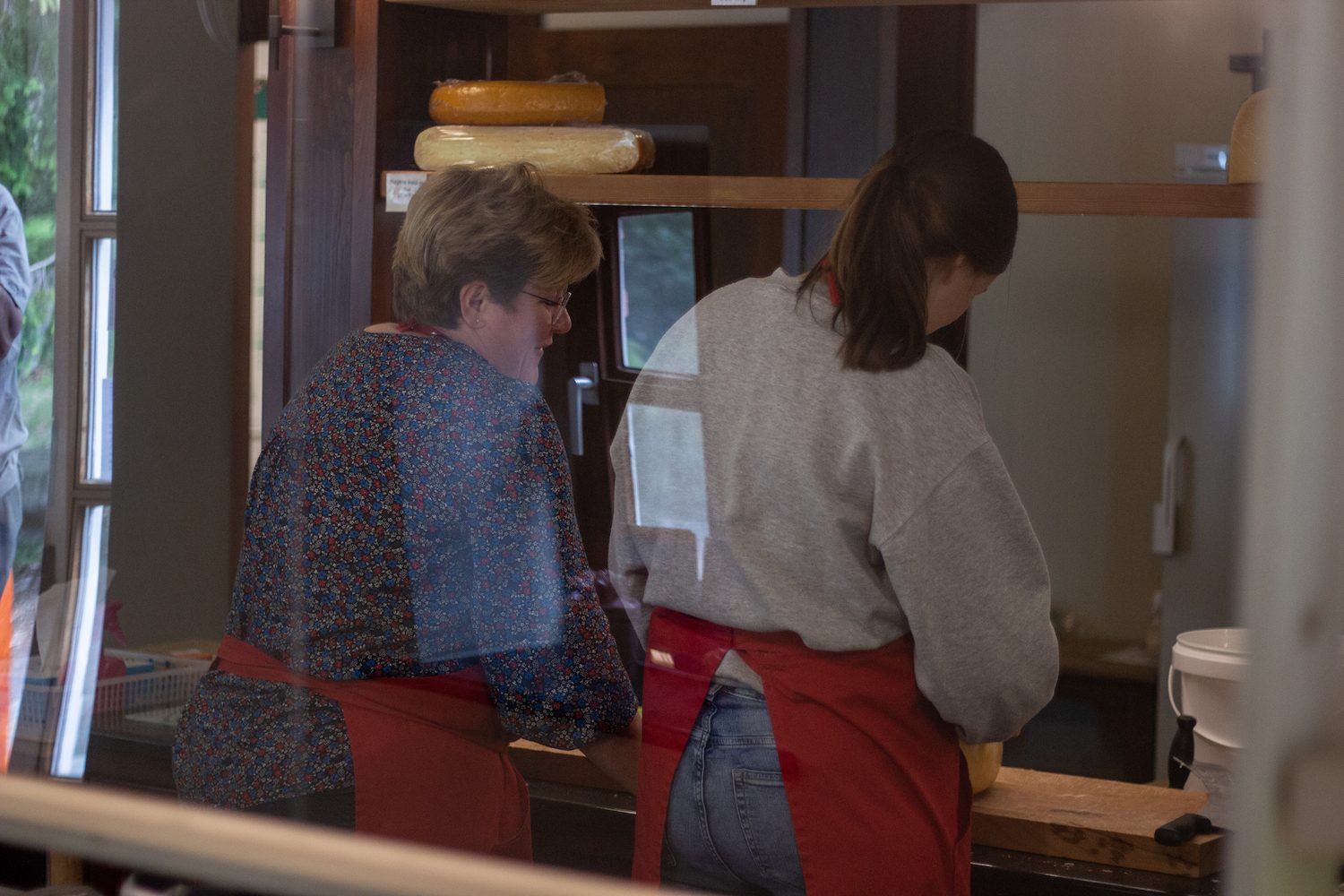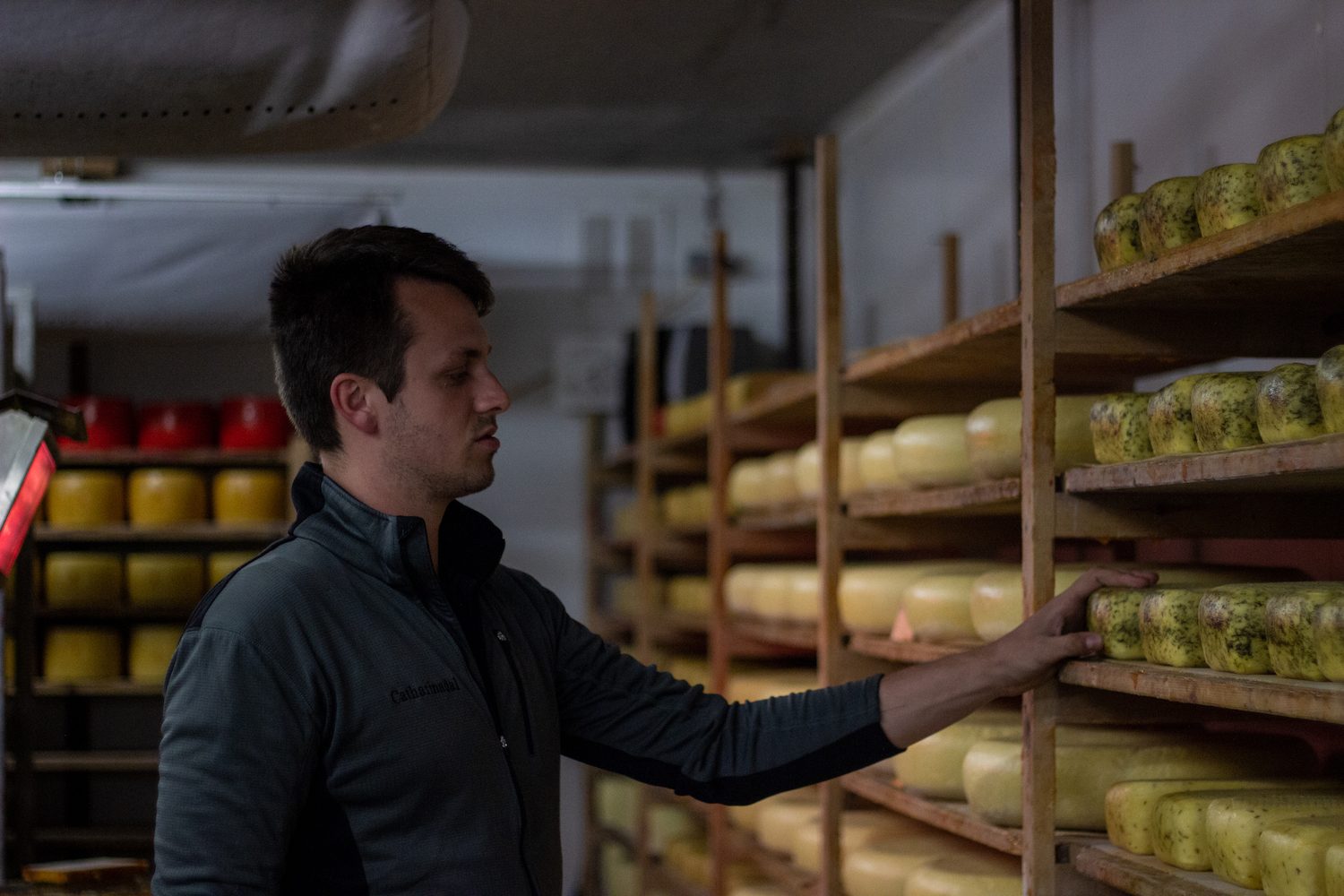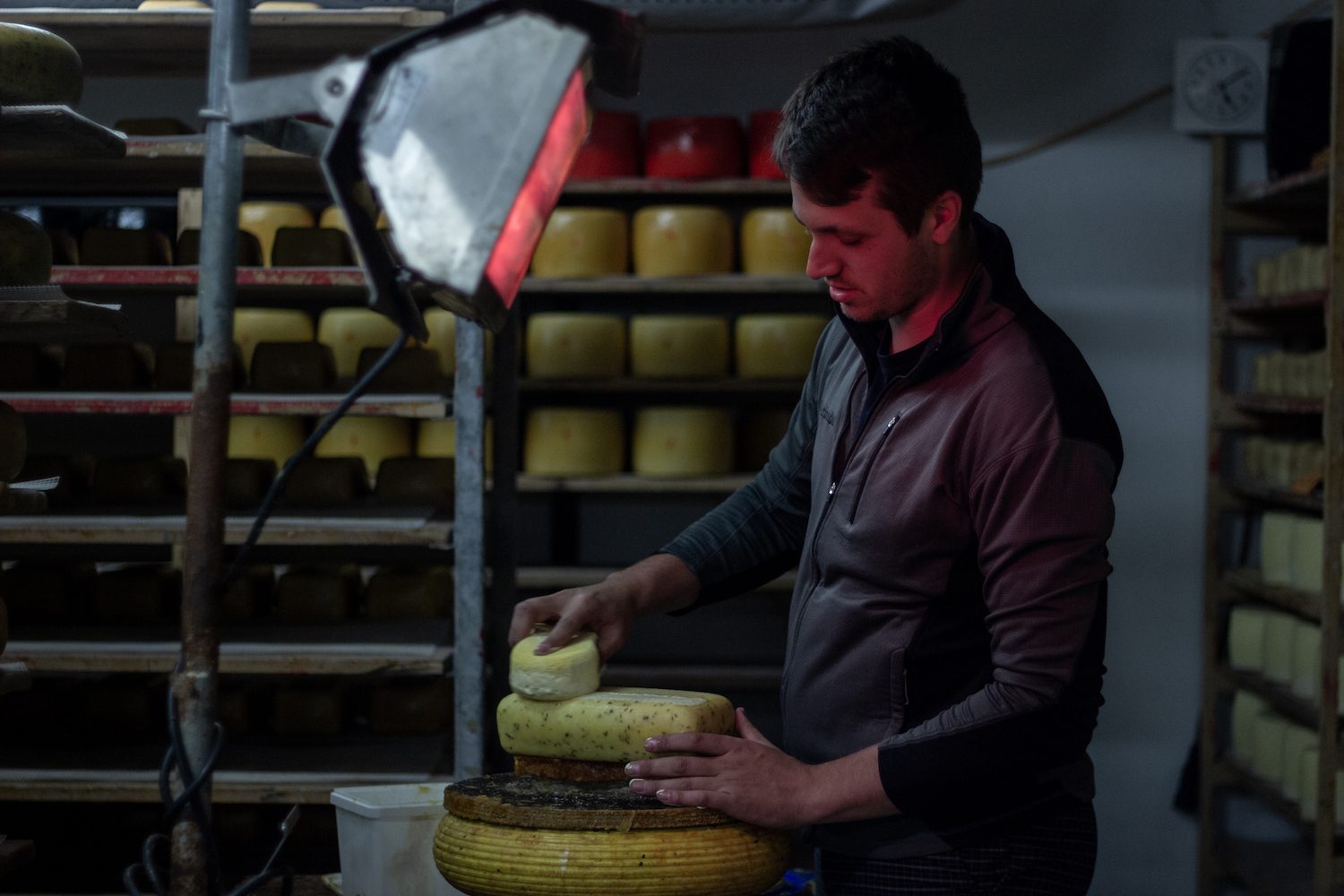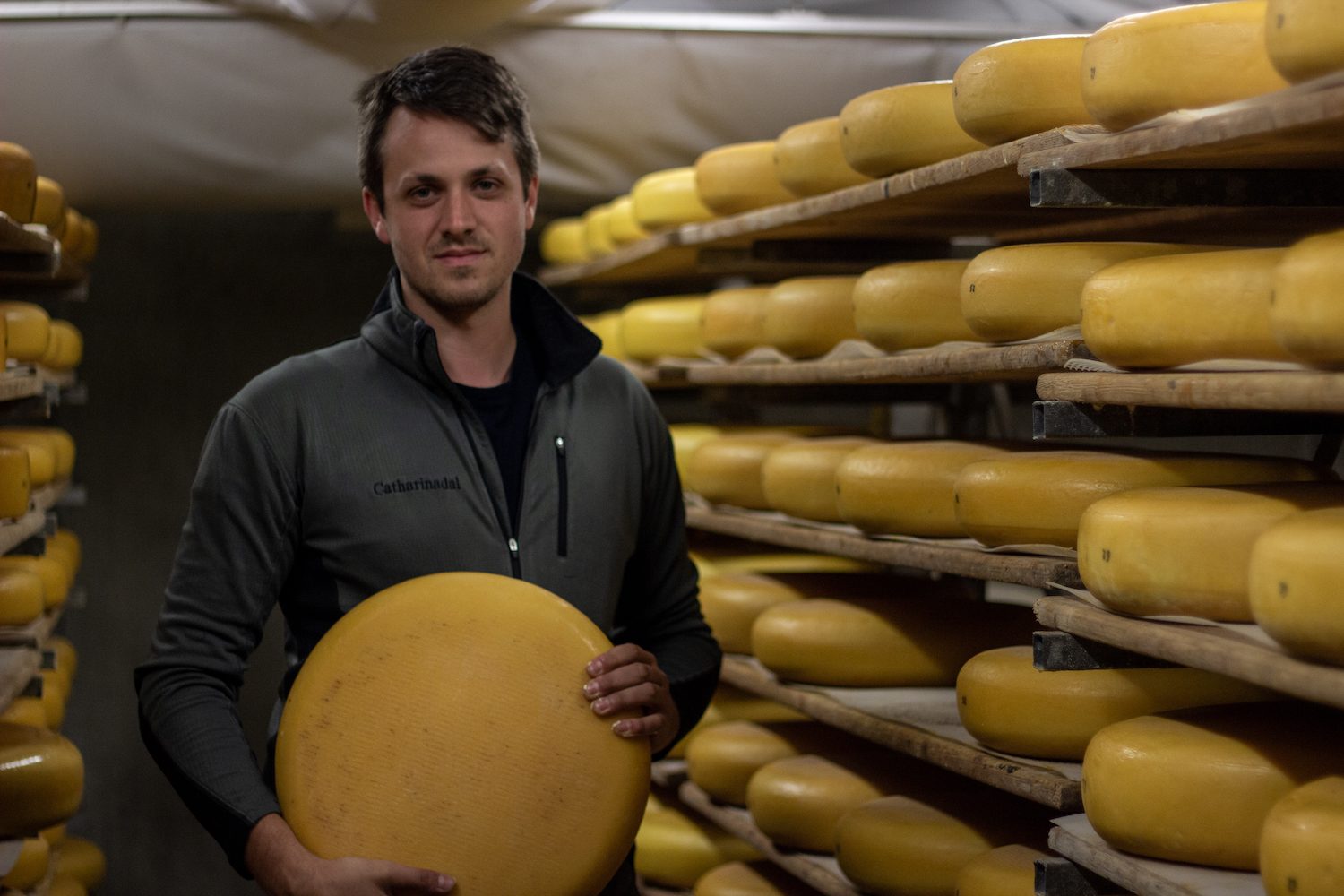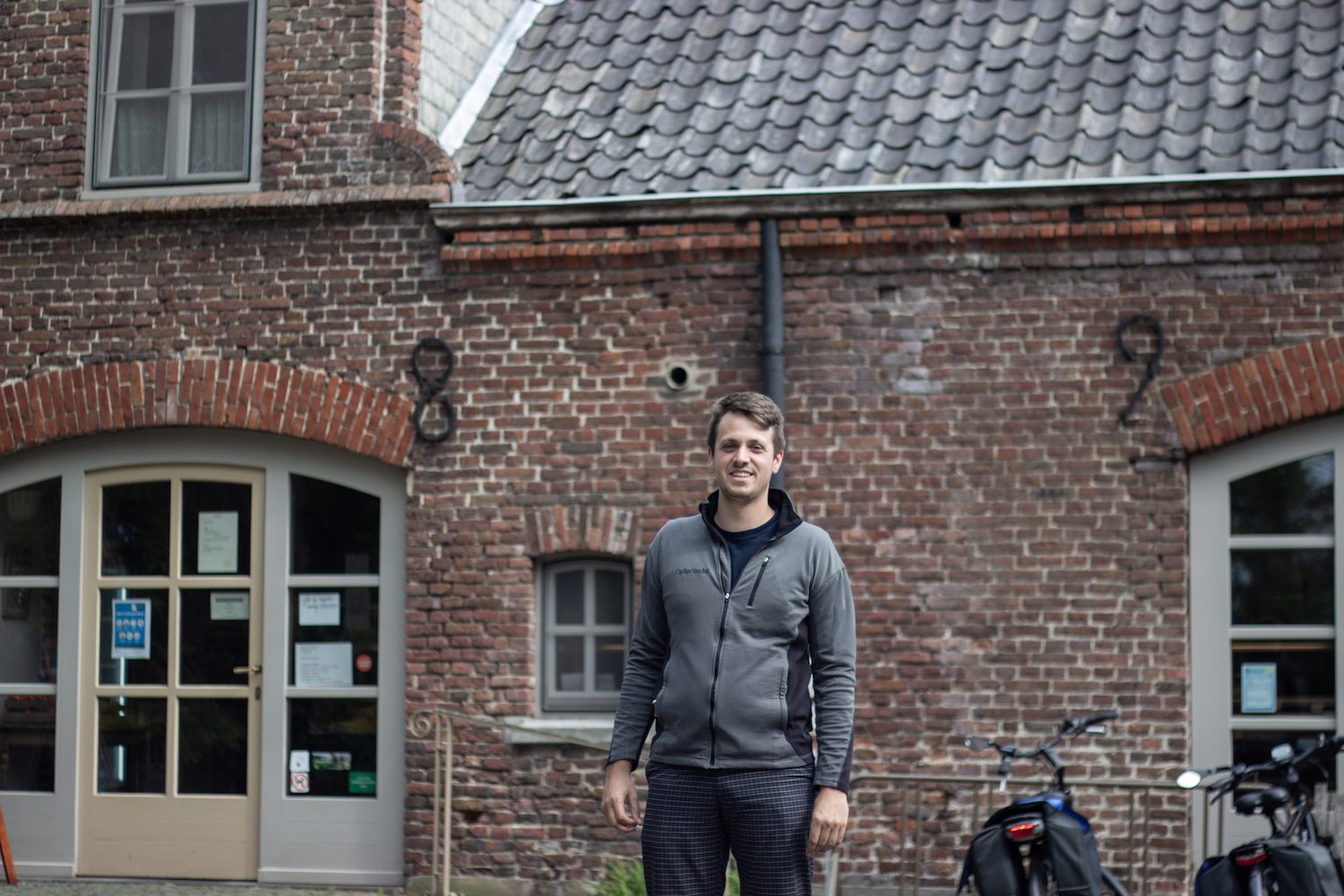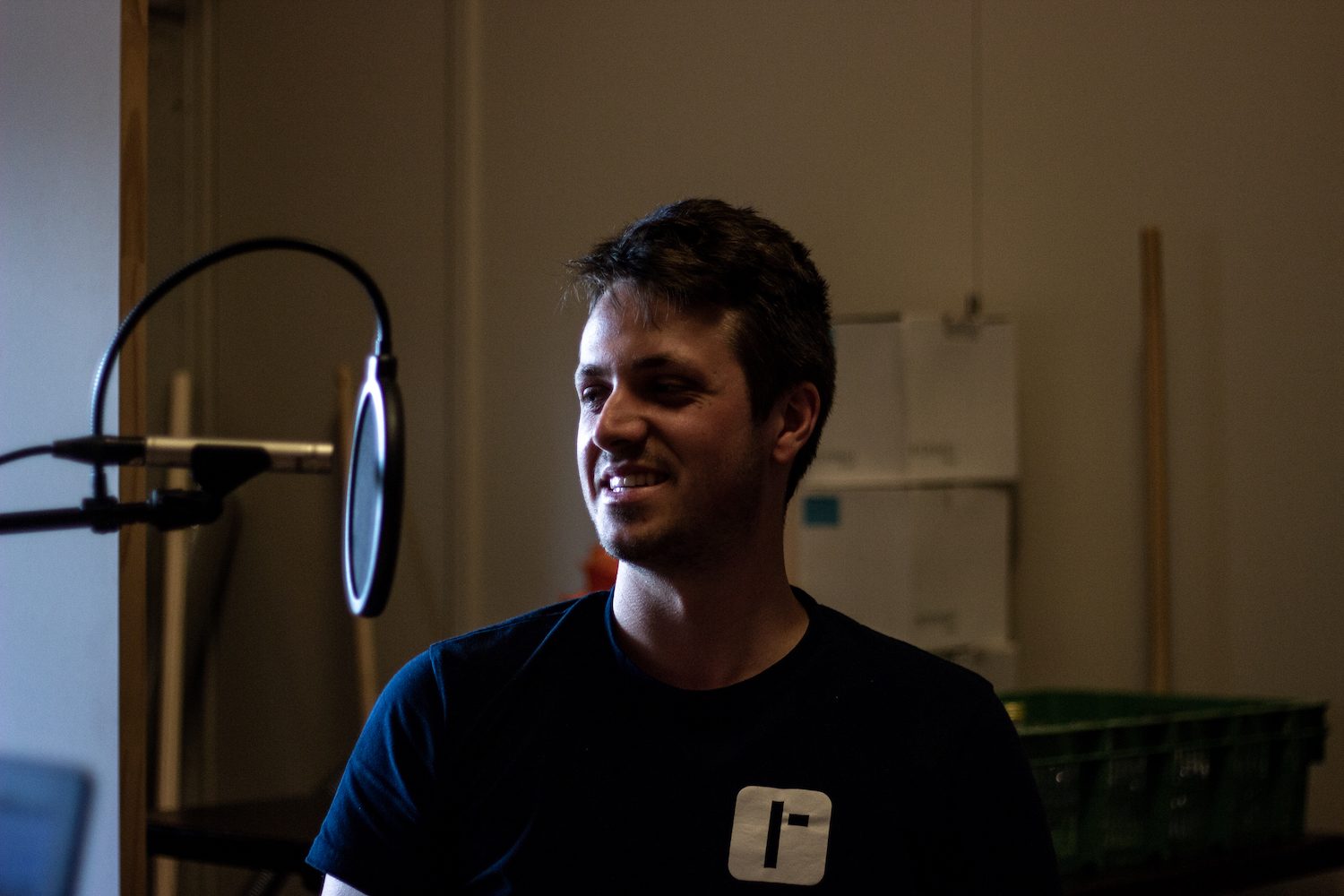An artisanal cheese maker from the Catharinadal cheese factory in Belgium created a new cheese as a romantic gesture for his wife. Just how did it became a world-famous blue cheese that delighted the international cheese community?
Words and photos by Breandán Kearney
Edited by Oisín Kearney & Ciara Elizabeth Smyth
This editorially independent story has been supported by VISITFLANDERS as part of the “Food Group” series. Read more.
In 2008, cheese maker Peter Boonen welcomed a group of cheesemongers to his small, artisanal cheese factory in the Belgian village of Achel, Kaasmakerij Catharinadal. Among the group were friends Peter Verbruggen and Luc Callebaut, secretly on the lookout for special cheeses that Callebaut could present at the prestigious national Cheese Masters competition of Belgium which was taking place later that year in Namur.
One of Peter Boonen’s cheeses sparked considerable debate amongst the cheesemongers, a blue cheese called the “Grevenbroeker”. Some of the cheesemongers didn’t like the cheese. More accustomed to the strong, salty flavours of Roquefort, they believed it lacked character. But Verbruggen and Callebaut were blown away. “I was overwhelmed by the aromas,” says Verbruggen. “It was creamy. It was soft. It was dense. It was perfect.”
Verbruggen and Boonen bought samples of the Grevenbroeker to share with their restaurant clients, such as Vivendum in Dilsen-Stokkem, run by chef Alex Clevers, and to use for the competition in Namur. When they left, Peter Boonen was unaware that the Grevenbroeker would be competing against the best cheeses in Belgium.
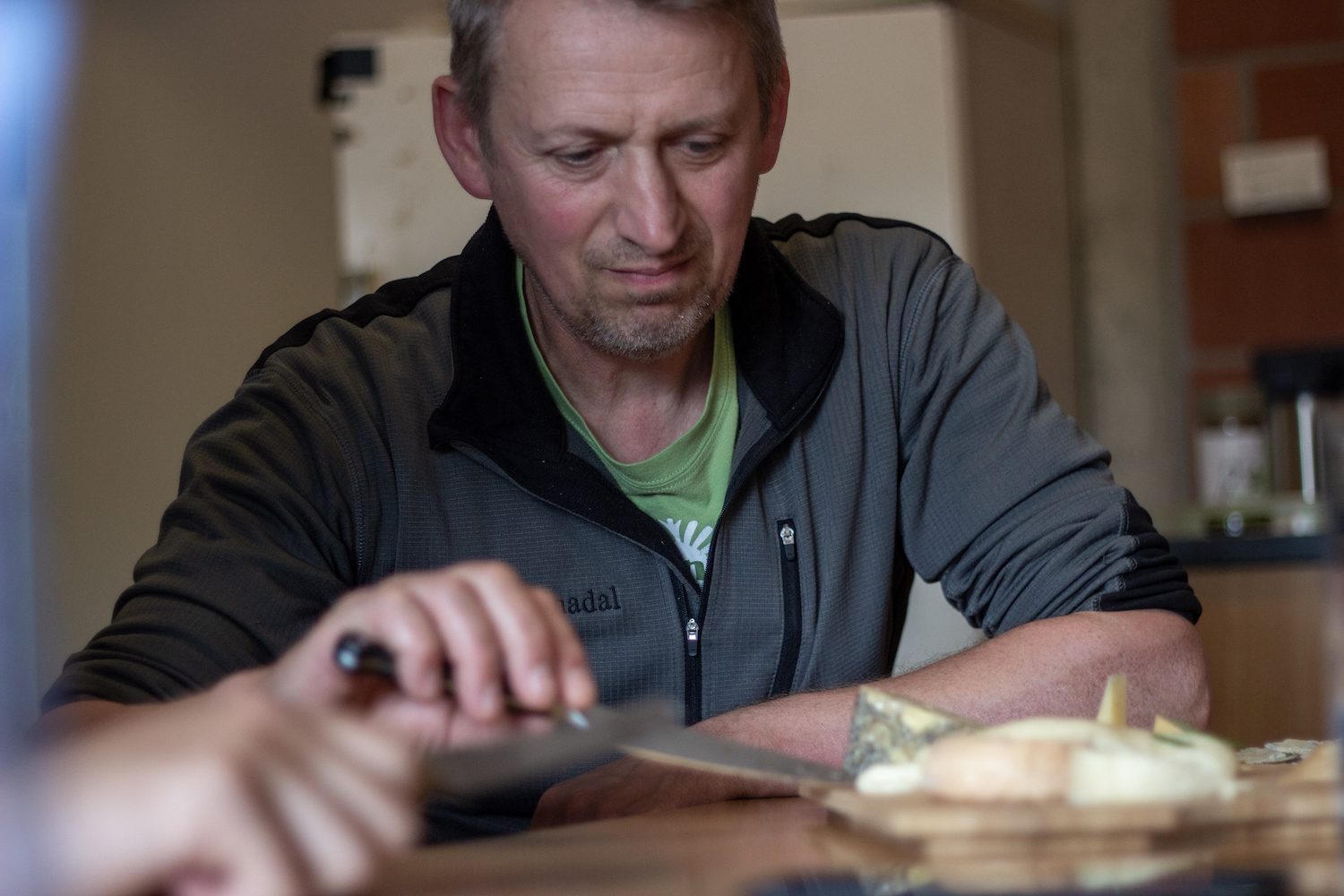
In 1989, Peter Boonen met Riet Thijs at a party of the local youth movement in Riet’s home village of Overpelt in Belgian Limburg. Twenty-four year old Riet was dark-haired and slender, with a sharp wit and dry sense of humour. At the time, she was working as a nurse in a local hospital. Peter, also twenty-four, was tall with short brown hair, pointed ears, a long nose, and hands belonging to a farmer: big and rough and calloused.
Peter felt an immediate spark with Riet at the party and in his nervousness to impress drank too many Trappist Achel beers. Seeing him transgressing into tipsiness, Riet told her friends that she didn’t think much of the young man she described as “the silly one from Achel”.
Achel is part of the fusion town of Hamont-Achel in Flanders, home to around 14,000 people as well as Brouwerij De Achelse Kluis, a brewery located within the walls of a Trappist Abbey. During the fourteenth and fifteenth centuries, Achel, Hamont, and Sint-Huibrechts-Lille together formed a small, autonomous state. “It was like Monaco or Liechtenstein,” says Peter Boonen. This mini-state was ruled from a large manor house—located at No.3 on Achel’s Catharinadal street—where nobles such as Robert van Grevenbroek once resided. Because of this, the mini-state had become known as the Grevenbroek.
Peter Boonen had been making cheese since he was thirteen years old at the family property which sat at No.5 on Catharinadal street. His parents had operated a dairy farm there, producing only milk and butter, and their two sons, Peter and his younger brother Bert helped on the farm. Peter’s parents gave him an allowance of milk and told him that whatever money he could generate from the milk, he could keep as pocket money. Rather than sell the milk, or try to make his own butter, Peter began making cheese, selling it at a higher price than milk or butter, and developing an interest in cheese production. The experience led Peter to study food sciences. His brother Bert enrolled for agricultural studies. The future of their family business was secured: Bert Boonen would inherit the dairy farm and Peter Boonen would open a cheese factory on site.
After they met at the party in Overpelt, Peter had been so persistent in courting Riet that she had eventually given him a chance to date her. Peter’s natural charm and go-getting nature began to win her over. Not long after becoming a couple, Peter opened a cheese shop beside his cheese factory at Catharinadal. The building in which the cheese shop was housed was once a Franciscan monastery and was converted into a farm in 1895 by Peter Boonen’s grandfather, Pieter-Johannes Boonen.
The date of the new cheese shop opening was 7 September 1990, important not only because it was the birthday of Peter’s mother, but also because it would be the first day that Riet would visit Catharinadal. Peter had tried his best to impress Riet with the shop, and while she was charmed by his endeavours, she saw it could be something more than it was.
A business partnership formed at the same time as a romantic one, and soon Riet was running and managing the cheese shop. Peter and Riet went on to be married and have two sons: Hendrik (now 25 years old) and Jan (now 26). Hendrik and Jan are both tall with short hair, pointed ears, and long noses. They both have their father’s farmer’s hands, big and rough and calloused, and their mother’s quick, dry, wit.
After Riet took over the running of the cheese shop, Peter began making and selling a blue cheese. “It’s not a cheese shop if you don’t have blue cheese in the shop,” says Peter Boonen. Blue cheese is produced by adding cultures of the mould penicillium to a cheese before or during ripening. It is this mould that gives blue cheese its spots or veins, and its green or blue colours. There are several famous blue cheeses. Gorgonzola comes from Italy. Stilton comes from England. Roquefort comes from France. All are rich, creamy, and pungent. One of the bacteria responsible for the smell of many blue cheeses—brevibacterium linens—is the same bacteria that causes foot odour in humans. Peter Boonen’s first blue cheese was a traditional one in the style of the French Roquefort: smelly, tangy, and salty. But this blue cheese did not sell in the shop at all. Peter was perplexed.
When he investigated, Peter discovered that Riet was refusing to sell the new blue cheese to customers, deliberately excluding it from both cheese tasting planks and the cheese assortments that Catharinadal offered. When Peter challenged Riet, she told him that she didn’t like the tangy and salty flavours of the blue cheese, and that she wouldn’t sell it in the shop. And so Peter vowed to create a new blue cheese that Riet would like.
If Peter failed, Riet wouldn’t sell the new blue cheese, and the Catharinadal shop might never gain the respect of other cheese shops in Belgium who sold their own blue cheeses. But more than that, Peter did not want to fail in making Riet happy. On 18 May 1993, Peter Boonen and Riet Thijs were married. Immediately after the wedding, Peter Boonen started work on developing Riet’s new blue cheese. He had no idea then that it would take him 14 years to make her happy.
In 1998, the Federal Agency for the Safety of the Food Chain visited Catharinadal and demanded that Peter replace his grandfather’s traditional wooden butter tun with a new, expensive, stainless steel one. They also insisted that his thirteen different cheese ripening rooms have separate ventilation systems so that air from one could not contaminate another. The changes required a huge capital investment and forced Peter to choose whether to stop or to scale up. He went all-in. He had to make and sell more cheeses to pay for the investment.
Then in 2002, Peter’s brother Bert Boonen switched the type of cow on his farm in order to reduce costs. He went for the Holstein cow, an incredibly adaptable breed with the highest milk production in the world which he hoped would result not only in greater yield, but in less taxes. The change, however, was a disaster. The Holstein cows did not feed well on Bert’s regular mix and required more expensive mixes of “power feed”. But the most devastating difference was the impact the change had on the taste and texture of the Catharinadal cheeses, which became less creamy, less rich, and less flavourful than before.
The cow Bert and Peter had been using before was an obscure variant of the Meuse Rhine Issel (MRI) breed of double-purpose cow known in Flanders as “Roodbont” (“Red Fur”). The milk from a Roodbont cow is of a much superior quality than a Holstein for making cheese, with both a higher average protein content and a higher average fat content than cow milk produced by the Holstein.
Peter and Bert immediately changed back to the Roodbont and the brothers agreed that the higher cost of milk production on the dairy farm would be made back in the cheese production. Bert had a regular buyer for his milk at a premium price and Peter had a guaranteed quality of milk from a farm only 3 kms away, with no middle men or logistical obstacles. The two businesses worked in symbiosis, and as a consequence, both businesses could survive. Peter knew that the milk he would use to make Riet’s new blue cheese would be the highest quality he could get.
To make a blue cheese that his wife Riet would be happy to sell in their shop, Peter knew from experience that he would need to conduct some experiments. Some of his previous experiments had yielded interesting cheeses, such as the “Burg”, a cow’s milk cheese containing Trappist beer from Achel, and washed with the same beer. Burg was chalky and hard in structure with a herbal aroma and a slightly bitter finish. But not all his experiments had resulted in success.
He had for a period tried to make a Gouda cheese with the addition of chilli peppers, weighing off the chilli peppers each time to the exact same amount. But there were too many unknown variables with the chilli peppers relating to the time of year and the climate in which they were grown, and he couldn’t find any consistency. Sometimes the cheese was so hot it couldn’t be eaten, and other times the spice in the cheese was barely noticeable.
Inspired by a popular bread baked with raisins that his friends often brought to eat with his cheese, Peter made a white cheese with raisins in it, adding the usual small amounts of salt in the milk for preservation and texture. After two months of aging, he opened the cheese and found that all of the salt had somehow ended up inside the raisins. Not only were the raisins so salty as to be inedible, but the cheese, no longer containing its salt addition for structure, became flimsy and fell apart.
Armed with these experiences, Peter set about to make his new blue cheese for Riet. Among other cultures such as lactobacillus, he would use penicillium glaucum mould rather than penicillium roqueforti, known to produce softer blue flavours. First, he tried adding less salt, but he faced challenges with the structure of the cheese. He then tried to make the curds dry so that bacteria which might make the cheese too intense had less chance of developing. But the moulding was never as desired.
He needed a new idea. What if he could facilitate a different way for the mould to grow and spread in the cheese, one that was slower and more organic? And then it clicked in his mind: stacking.
If he stacked the curds gently on top of each other in a precarious puzzle without pressing them or putting too much weight on them, the blue mould present in one of the cheeses would eventually find its way naturally into the other cheeses in the stack. There would be no need to pierce and inject each one of them with blue mould. The flavours might just be less tangy and less intense.
The texture of the curds needed to be perfect for it to work: soft and moist enough that air could enter and bacteria could spread across the stack, but not so soft or moist that the cheeses couldn’t properly be stacked on one another without them collapsing. “It would fall like a card building,” says Peter of the consequences of an incorrect texture. The curds were exposed to the air for two months, after which they were closed up on the exterior. When the new cheese was ready, all that was left was to get Riet’s verdict.
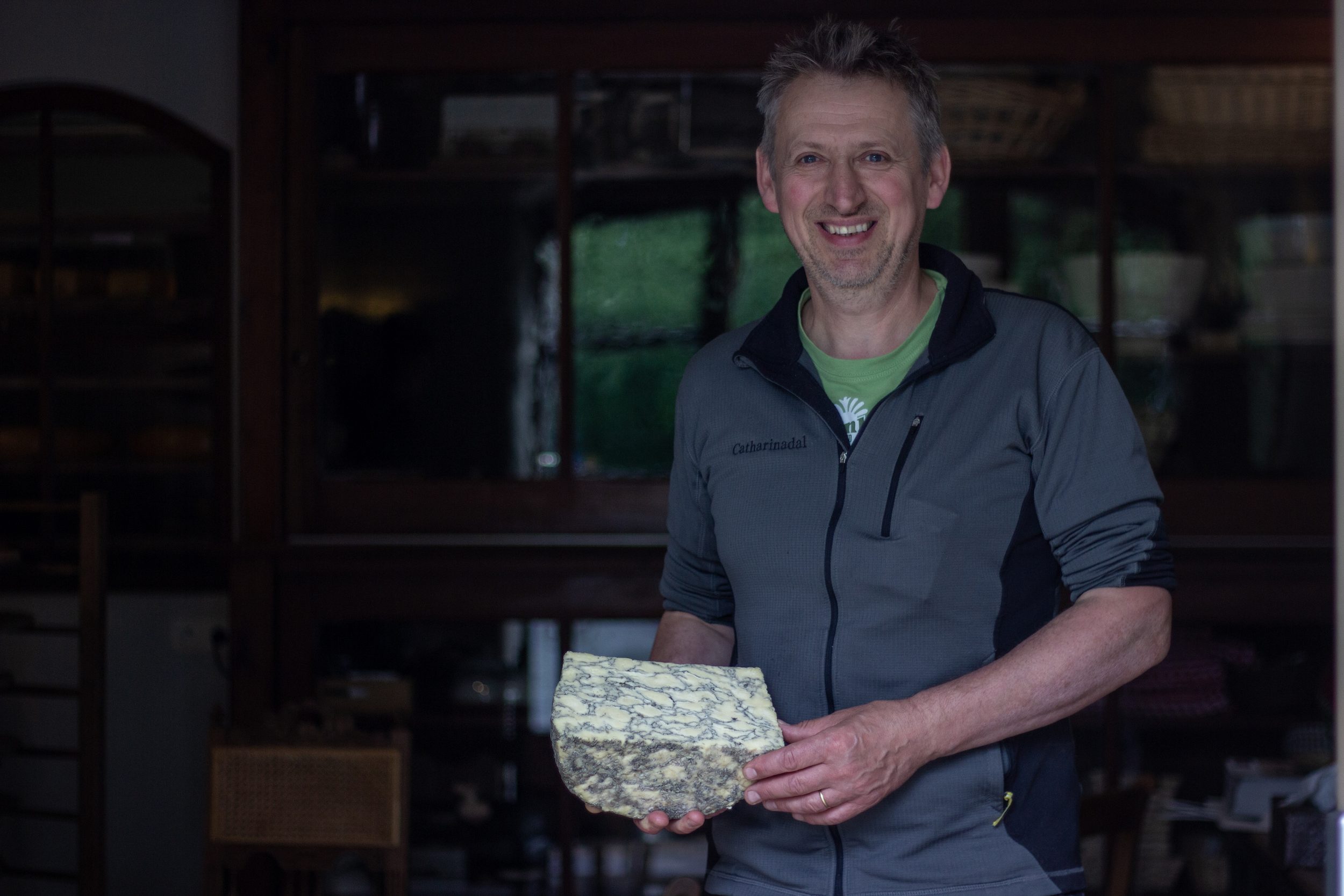
When Riet tasted the new cheese, she was struck by two things.
Firstly, the appearance was distinctive. It had the familiar blue veins of other blue cheeses but these were less defined and more meandering. When he cut the cheese open for Riet, it was white inside, but after a few seconds, exposed to the air, the blue suddenly began to appear. Because the mould hadn’t been injected into holes, but rather allowed to wander through the stack, it produced a dusting of patterns, a marble-like design as on the walls of Rome’s Pantheon or on the domes of Agra’s Taj Mahal. Riet knew that the new cheese would dress up any cheeseboard.
Secondly, the cheese didn’t have the salty, sharp, tangy, almost spicy taste of other blue cheeses, but rather it was mellow, rich, and creamy. Riet tasted all the depth and complexity of the blue flavours, and loved its sweet, soft character. She began selling it in the Catharinadal cheese shop under the name “Grevenbroeker”.
The Grevenbroeker sold well to locals who frequented the Catharinadal shop now that Riet was happy to include it in her tasting planks and assortments. But it was still completely unknown outside of the Grevenbroek: Achel, Hamont, and Sint-Huibrechts-Lille. Peter Boonen made it only once per year, limiting production to 50 Grevenbroekers each time. The Grevenbroeker was a cheese destined to exist in the background.
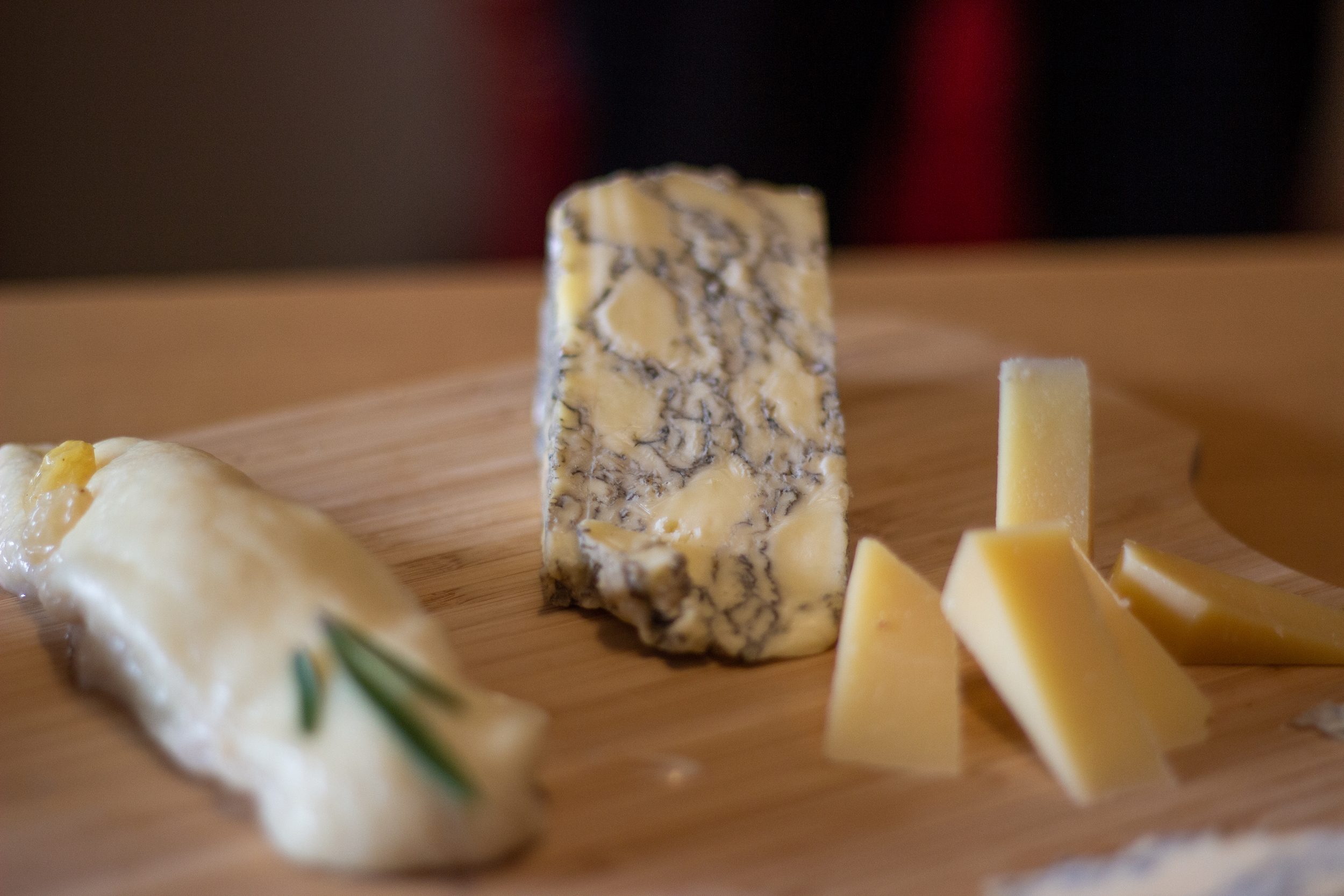
And then in 2008, Luc Callebaut won the title of “First Cheese Master of Belgium” at the prestigious national Cheese Masters competition in Namur. He won by presenting the Grevenbroeker to the judges.
As the First Cheese Master of Belgium, Callebaut was invited to the Caseus Awards, the most important international cheese competition in the world, taking place the following January in France. Luc Callebaut and Peter Verbruggen called Peter Boonen to ask his permission for them to bring the Grevenbroeker to the Caseus Awards. Humbled, Peter said yes. Riet’s cheese would be competing against cheeses from all around the world—not just for Catharinadal and for Achel—but on behalf of the whole of Belgium.
The Caseus Awards is a serious competition. “It’s the Olympic games for cheesemongers,” says Peter Verbruggen. Like the Olympics, it’s held only once every four years. In 2009, Callebaut and Verbruggen were expected to bring a Belgian cheese to compete against cheeses from around the world in one of the various categories.
Luc Callebaut had managed a cheese shop in Oudenaarde in East Flanders since 1999 with his wife, the cheese expert Nathalie Vanhaver, and the couple were in the process of opening up their own ripening chambers. Peter Verbruggen managed a cheese shop called ‘t Kaasplankske with his wife Ingrid Wijckmans which was located in Beringen in Belgian Limburg, and had established a company called “Cheese Made in Belgium” which was on its way to becoming the most important exporter of artisanal Belgian cheese to the USA.
Callebaut and Verbruggen were agreed in their decision to bring the Grevenbroeker to France. But when word got out in Belgium, Callebaut and Verbruggen started to receive some negative comments from other Belgian cheesemongers who were not happy with the choice. Some of the more traditional cheesemongers in Belgium told Verbruggen that the Grevenbroeker was too soft and too subtle in flavour for a blue cheese, not special enough, and that it would not stand a chance against the sharper, saltier, more intense blue cheeses from France.
And Luc Callebaut and Peter Verbruggen were travelling to the Caseus Awards without the prestige and history of French Roquefort, English Stilton, or Italian Gorgonzola, each of which had their own designation of origin appellations.
In addition, the Grevenbroeker had been entered into one of the most prestigious and hotly contested categories—“Best Original Cheese”—where regionality and farm-to-table values are considered important. Given how much the international cheese community obsesses over finding hidden gems in the cheese world, the competition would be intense and the scrutiny on Peter Boonen’s Grevenbroeker was likely to be ruthless.
In 2008, Catharinadal were selling their cheese to locals who would drop into their shop every weekend. Outside of the Grevenbroek triangle—Achel, Hamont, and Sint-Huibrechts-Lille—the Grevenbroeker was still relatively unknown. Peter Verbruggen and Luc Callebaut asked Peter Boonen if he’d like to come along with them to the Caseus Awards in Lyon so that he could hear what the international cheese community thought of the Grevenbroeker.
But then, a few weeks before the competition, Riet Thijs found a small hard lump on her breast and her doctor sent her for a mammogram and an ultrasound. She was diagnosed with breast cancer. While Luc Callebaut and Peter Verbruggen were setting off to the Caseus Awards in Lyon with the Grevenbroeker, both unaware of Riet’s illness, Peter Boonen was sitting in the hospital in Overpelt helping Riet prepare for cancer treatment.
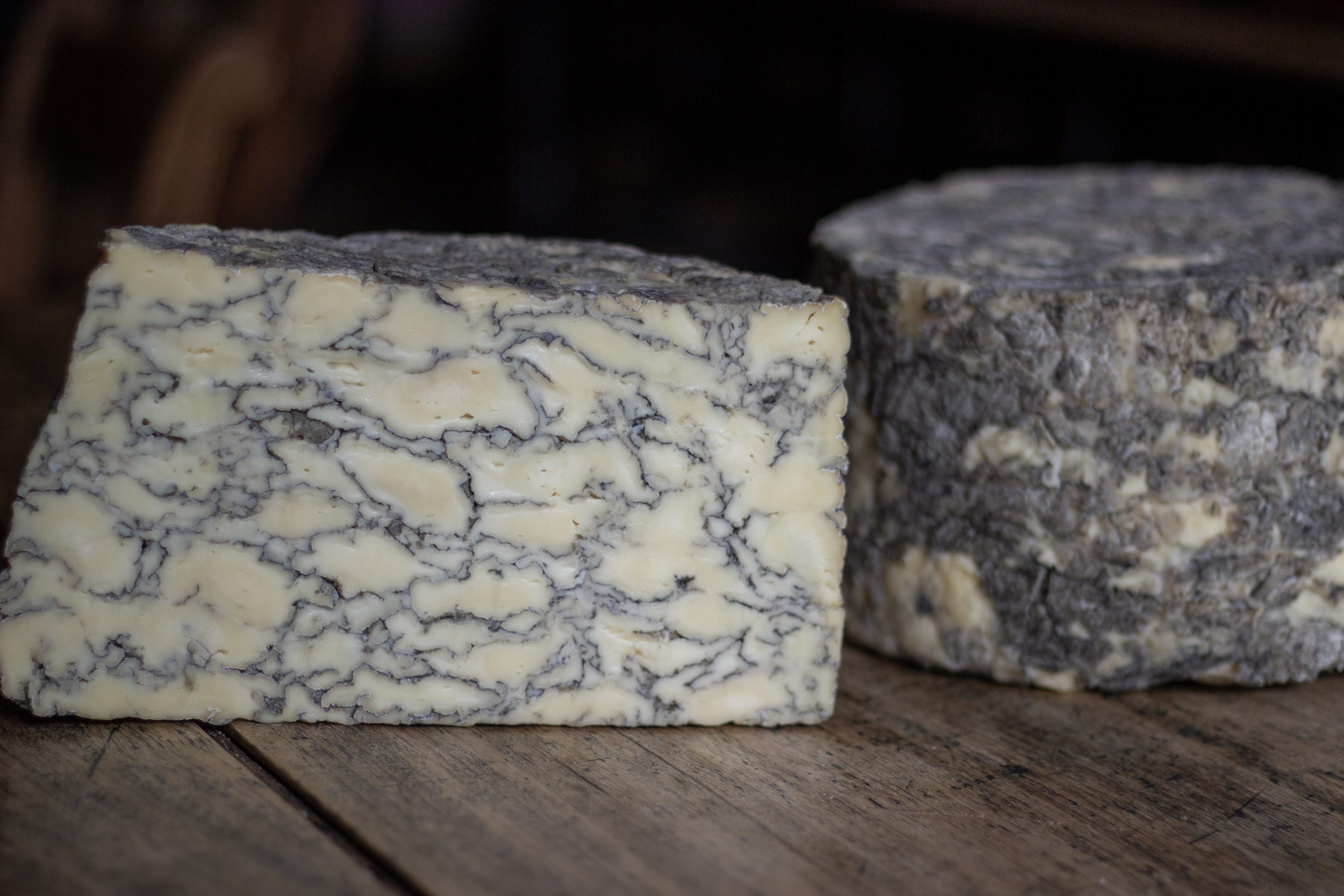
The Grevenbroeker was presented to the judges at the International Caseus Awards on Saturday 24 January 2009 in the Eurexpo, one of France’s biggest exhibition venues, located in the south-east of Lyon. Each country competing was represented by a team of two cheesemongers who had come through their own national selection processes.
Luc Callebaut and Peter Verbruggen were stripping out for Belgium in what was essentially the Cheese Olympics. Christophe Gremaud De Bulle and Mirielle Kuttel De Joan were strong contenders from Switzerland. Italy’s Cominelli Graziano and Giandomenico Negro were said to have brought wonderful cheese. Miyuki Murase and Yoko Inoue from Japan were dark horses for an upset. And playing at home, the French—Cédric Lenoir and Audrey Milliart—were expected to dominate. Fifteen countries were competing for the prize of “Best Original Cheese”. Like the Olympics, the teams mingled nervously and privately prepared for their big performances. Nobody gave any chance to a soft blue cheese from an obscure Limburg cheese factory in the tiny country of Belgium.
Callebaut and Verbruggen had done their research. They had contacted two Belgian chefs with samples of the Grevenbroeker for ideas on how best to show off its full array of flavours: one star Michelin chef Alex Clevers of Vivendum in Dilsen-Stokkem; and Marc Bonneu from the Koeckhofs in Achel. When Belgium was called by a 22-person judging panel made up of cheese experts from 22 different countries, Peter Verbruggen stepped up with the Grevenbroeker in front of a crowd of 300 attentive professionals.
First, Verbruggen paired the Grevenbroeker with Crème Brûlée, the soft, fudgy nature of the cheese evolving into a sweet, chocolate-like creaminess in the mouth, with a distinct peppery bite on the finish for balance. Secondly, he paired it with a lollipop stick made from berries which complimented the sweet nature of the Grevenbroeker and its dried fruit notes. And lastly, because they were representing Belgium in France, he presented the Grevenbroeker with a Brussels waffle. The Boonen family’s beginnings in butter production echoed in this final combination, as the rich, almost yoghurt-like spoonability of the buttery Grevenbroeker blew the judges away. This was an Original Cheese.
Peter Boonen received the phone call from Verbruggen almost immediately after the results of the competition were announced. He was standing in the Overpelt hospital, with Riet in her bed next to him. Verbruggen’s voice was hurried and high pitched. The Grevenbroeker had won, scoring 18.4 points out of a possible 20, taking the title of the “Best Original Cheese” at the International Caseus Awards of 2009. Boonen was quiet on the phone, but after a few seconds, he thanked Verbruggen. Peter Boonen then told Riet. Despite being low on energy, and barely able to express herself, she managed one of her trademark dry remarks, quipping that at least there would be something else to talk about in the cheese shop instead of her and her illness.
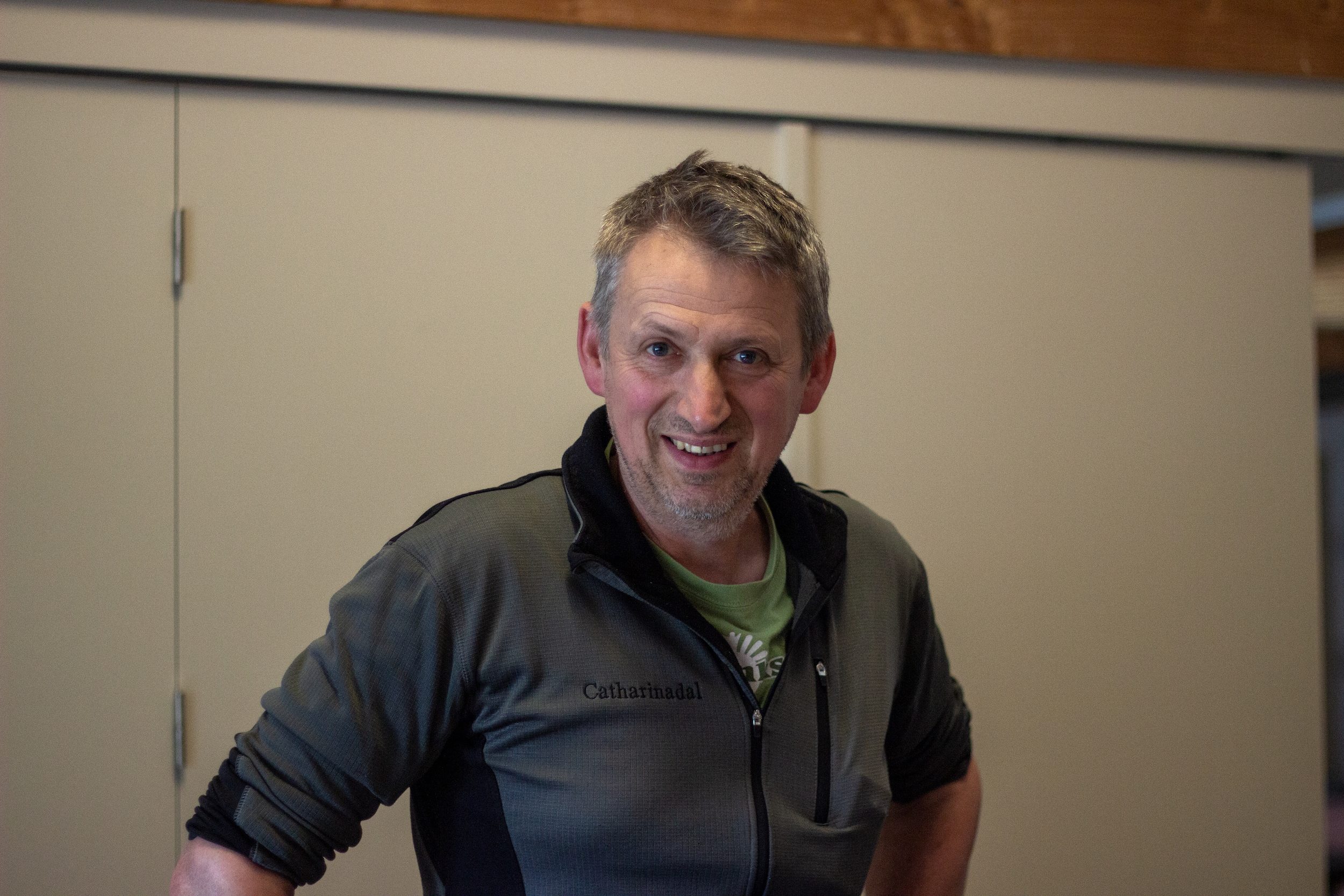
The media descended on Catharinadal. Peter Boonen did several interviews on national television, subtitled because of his strong dialect. Sales of Grevenbroeker exploded. Where before, Peter was making 50 Grevenbroekers per year, today he makes 1600. “Every respected chef in Belgium has it on his cheese platter,” says Peter Verbruggen. Even those cheesemongers who criticised his cheese initially started to buy it after it won Best Original Cheese at the Caseus Awards in Lyon.
Verbruggen and his “Cheese Made in Belgium” export company received more and more orders for the Grevenbroeker, especially from New York and San Francisco. Few outside Belgium, and practically no-one in the US, could pronounce the name of the Grevenbroeker. Now a trusted commercial partner of Peter Boonen, Peter Verbruggen suggested they sell it under a different name to international markets: the “Achelse Blauwe” or “Achel Blue”. Grevenbroeker was a complicated historical reference relating to the autonomous mini-state of Achel, Hamont, and Huibrechts-Lille, while Achelse Blauwe signified both the name of the village as well as the type of cheese. Peter Boonen agreed for commercial reasons, but still sells the cheese today from the Catharinadal cheese shop as the Grevenbroeker.
Riet Thijs underwent chemotherapy at the Overpelt Hospital and radiation therapy at the hospital in Genk. Bert Boonen’s wife Carine took over the day to day running of the cheese shop. Other family members took temporary or part time leave from their jobs to lend a hand. Riet, now 56 years old, is in remission, back spending time with the family at Catharinadal and helping with the business on some days. But she’s still low on energy, becoming more tired more frequently.
Peter and Riet’s sons Hendrik and Jan work other jobs but both are becoming more and more involved in the family cheese factory. They’ve grown up with farming and cheese, seeing how much work their parents have invested in their passion and their business. “My mother is happy that her sons are getting more involved,” says Hendrik Boonen of his mother, Riet. “She says she doesn’t have to listen so much to my father.”
Since it won the Caseus Award twelve years ago, Peter has continued experimenting, rolling out two more versions of the Grevenbroeker.
In addition to the original version, there’s the “Pikant”, a spicier variant ripened for five months whose blue veining is less pronounced.
There’s also the “Extra”, an intensely spicy and tangy variant of the Grevenbroeker, firm in structure and darker in colour, which is matured for twelve months.
“It’s very old,” says Peter Boonen of the Extra, sharing a cheese plank of various cheeses with his son Hendrik Boonen in the small staff kitchen at Catharinadal.
“If you breathe, you get it in the back of your throat,” says Hendrik.
“It’s not for Riet,” says Peter, before bursting out laughing.
But everything Peter Boonen does is for Riet. That’s true now more than ever, thirty-two years after the party in Overpelt where they met. For Riet, he’s not as much a world-class cheese maker, as just the “silly one from Achel”.
*


